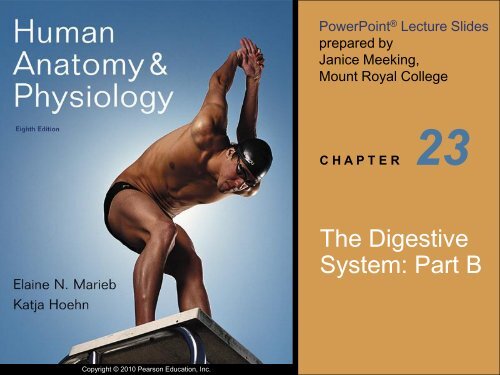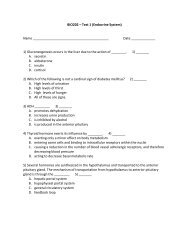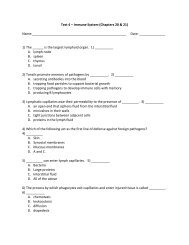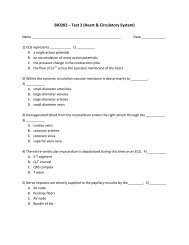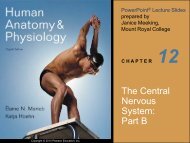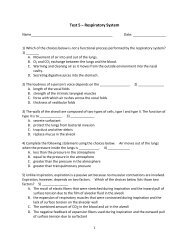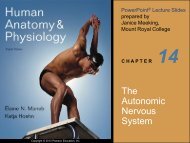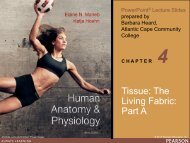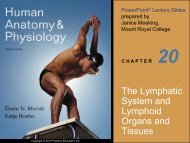The Digestive System: Part B - Next2Eden
The Digestive System: Part B - Next2Eden
The Digestive System: Part B - Next2Eden
Create successful ePaper yourself
Turn your PDF publications into a flip-book with our unique Google optimized e-Paper software.
Copyright © 2010 Pearson Education, Inc.<br />
PowerPoint ® Lecture Slides<br />
prepared by<br />
Janice Meeking,<br />
Mount Royal College<br />
C H A P T E R<br />
23<br />
<strong>The</strong> <strong>Digestive</strong><br />
<strong>System</strong>: <strong>Part</strong> B
Pharynx<br />
• Oropharynx and laryngopharynx<br />
• Allow passage of food, fluids, and air<br />
• Stratified squamous epithelium lining<br />
• Skeletal muscle layers: inner longitudinal,<br />
outer pharyngeal constrictors<br />
Copyright © 2010 Pearson Education, Inc.
Esophagus<br />
• Flat muscular tube from laryngopharynx to<br />
stomach<br />
• Pierces diaphragm at esophageal hiatus<br />
• Joins stomach at the cardiac orifice<br />
Copyright © 2010 Pearson Education, Inc.
(a)<br />
Copyright © 2010 Pearson Education, Inc.<br />
Mucosa<br />
(contains a stratified<br />
squamous epithelium)<br />
Submucosa (areolar<br />
connective tissue)<br />
Lumen<br />
Muscularis externa<br />
• Longitudinal layer<br />
• Circular layer<br />
Adventitia (fibrous<br />
connective tissue) not<br />
serosa<br />
Figure 23.12a
<strong>Digestive</strong> Processes: Mouth<br />
1. Ingestion<br />
2. Mechanical digestion<br />
• Mastication is partly voluntary, partly<br />
reflexive<br />
3. Chemical digestion (salivary amylase<br />
and lingual lipase)<br />
4. Propulsion<br />
• Deglutition (swallowing)<br />
Copyright © 2010 Pearson Education, Inc.
Copyright © 2010 Pearson Education, Inc.<br />
Bolus of food<br />
Tongue<br />
Pharynx<br />
Epiglottis<br />
Glottis<br />
Trachea<br />
1<br />
Upper esophageal sphincter is contracted. During<br />
the buccal phase, the tongue presses against the hard<br />
palate, forcing the food bolus into the oropharynx<br />
where the involuntary phase begins.<br />
Figure 23.13, step 1
Copyright © 2010 Pearson Education, Inc.<br />
Esophagus<br />
Uvula<br />
Bolus<br />
Epiglottis<br />
2<br />
<strong>The</strong> uvula and larynx rise to prevent food from<br />
entering respiratory passageways. <strong>The</strong> tongue blocks<br />
off the mouth. <strong>The</strong> upper esophageal sphincter<br />
relaxes, allowing food to enter the esophagus.<br />
Figure 23.13, step 2
Copyright © 2010 Pearson Education, Inc.<br />
Bolus<br />
3<br />
<strong>The</strong> constrictor muscles of the pharynx contract,<br />
forcing food into the esophagus inferiorly. <strong>The</strong> upper<br />
esophageal sphincter contracts (closes) after entry.<br />
Figure 23.13, step 3
Relaxed muscles<br />
Circular muscles<br />
contract<br />
Bolus of food<br />
Longitudinal muscles<br />
contract<br />
Gastroesophageal<br />
sphincter closed<br />
Copyright © 2010 Pearson Education, Inc.<br />
Stomach<br />
4<br />
Food is moved through<br />
the esophagus to the<br />
stomach by peristalsis.<br />
Figure 23.13, step 4
Copyright © 2010 Pearson Education, Inc.<br />
Relaxed<br />
muscles<br />
5<br />
<strong>The</strong> gastroesophageal<br />
sphincter opens, and food<br />
enters the stomach.<br />
Gastroesophageal<br />
sphincter opens<br />
Figure 23.13, step 5
Stomach: Gross Anatomy<br />
• Cardiac region (cardia)<br />
• Surrounds the cardiac orifice<br />
• Fundus<br />
• Dome-shaped region beneath the<br />
diaphragm<br />
• Body<br />
• Midportion<br />
• Pyloric Antrum pyloric canal<br />
Copyright © 2010 Pearson Education, Inc.
Esophagus<br />
Muscularis<br />
externa<br />
• Longitudinal layer<br />
• Circular layer<br />
• Oblique layer<br />
Lesser<br />
curvature<br />
(a)<br />
Copyright © 2010 Pearson Education, Inc.<br />
Duodenum<br />
Cardia<br />
Pyloric<br />
canal<br />
Pyloric sphincter<br />
(valve) at pylorus<br />
Pyloric<br />
antrum<br />
Fundus<br />
Serosa<br />
Body<br />
Lumen<br />
Rugae of<br />
mucosa<br />
Greater<br />
curvature<br />
Figure 23.14a
Stomach: Gross Anatomy<br />
• Two mesenteries:<br />
• Lesser omentum<br />
• From the liver to the lesser curvature<br />
• Greater omentum<br />
• Drapes from greater curvature<br />
• Anterior to the small intestine<br />
Copyright © 2010 Pearson Education, Inc.
(a)<br />
Copyright © 2010 Pearson Education, Inc.<br />
Falciform ligament<br />
Liver<br />
Gallbladder<br />
Spleen<br />
Stomach<br />
Ligamentum teres<br />
Greater omentum<br />
Small intestine<br />
Cecum<br />
Figure 23.30a
Liver<br />
Gallbladder<br />
Lesser omentum<br />
Stomach<br />
Duodenum<br />
Transverse colon<br />
Small intestine<br />
Cecum<br />
Urinary bladder<br />
Copyright © 2010 Pearson Education, Inc.<br />
(b)<br />
Figure 23.30b
Stomach: Gross Anatomy<br />
• ANS nerve supply<br />
• Sympathetic via splanchnic nerves and<br />
celiac plexus<br />
• Parasympathetic via vagus nerve<br />
• Blood supply<br />
• Celiac trunk<br />
• Veins of the hepatic portal system<br />
Copyright © 2010 Pearson Education, Inc.
Stomach: Microscopic Anatomy<br />
• Four tunics<br />
• Muscularis and mucosa are modified<br />
• Muscularis externa<br />
Copyright © 2010 Pearson Education, Inc.<br />
• Three layers of smooth muscle<br />
• Inner oblique layer allows stomach to churn,<br />
mix, move, and physically break down food
Copyright © 2010 Pearson Education, Inc.<br />
Mucosa<br />
Submucosa<br />
(contains submucosal<br />
plexus)<br />
Muscularis externa<br />
(contains myenteric<br />
plexus)<br />
Serosa<br />
Surface<br />
epithelium<br />
Lamina propria<br />
Muscularis<br />
mucosae<br />
Oblique layer<br />
Circular layer<br />
Longitudinal<br />
layer<br />
(a) Layers of the stomach wall (l.s.)<br />
Stomach wall<br />
Figure 23.15a
Stomach: Microscopic Anatomy<br />
• Mucosa<br />
• Simple columnar epithelium composed of<br />
mucous cells<br />
Copyright © 2010 Pearson Education, Inc.<br />
• Layer of mucus traps bicarbonate-rich<br />
fluid beneath it<br />
• Gastric pits lead into gastric glands
Gastric<br />
pit<br />
Gastric<br />
gland<br />
Copyright © 2010 Pearson Education, Inc.<br />
Gastric pits<br />
Surface epithelium<br />
(mucous cells)<br />
Mucous neck cells<br />
Parietal cell<br />
Chief cell<br />
Enteroendocrine cell<br />
(b) Enlarged view of gastric pits and gastric glands<br />
Figure 23.15b
Gastric Glands<br />
• Cell types<br />
• Mucous neck cells (secrete thin, acidic<br />
mucus)<br />
• Parietal cells (HCl + intrinsic factor)<br />
• Chief cells (pepsinogen + lipases)<br />
• Enteroendocrine cells (histamine,<br />
serotonin, somatostatin, GASTRIN)<br />
Copyright © 2010 Pearson Education, Inc.
Copyright © 2010 Pearson Education, Inc.<br />
Mitochondria<br />
Parietal cell<br />
Chief cell<br />
Enteroendocrine<br />
cell<br />
Pepsinogen<br />
HCl<br />
Pepsin<br />
(c) Location of the HCl-producing parietal cells and<br />
pepsin-secreting chief cells in a gastric gland<br />
Figure 23.15c
Gastric Gland Secretions<br />
• Glands in the fundus and body produce most of the<br />
gastric juice<br />
• Parietal cell secretions<br />
• HCl<br />
Copyright © 2010 Pearson Education, Inc.<br />
• pH 1.5–3.5 denatures protein in food, activates<br />
pepsin, and kills many bacteria<br />
• Intrinsic factor<br />
• Glycoprotein required for absorption of vitamin B 12<br />
in small intestine
Gastric Gland Secretions<br />
• Chief cell secretions<br />
• Inactive enzyme pepsinogen<br />
• Activated to pepsin by HCl and by pepsin itself<br />
(a positive feedback mechanism)<br />
Copyright © 2010 Pearson Education, Inc.
Gastric Gland Secretions<br />
• Enteroendocrine cells<br />
• Secrete chemical messengers into the<br />
lamina propria<br />
Copyright © 2010 Pearson Education, Inc.<br />
• Paracrines<br />
• Serotonin and histamine<br />
• Hormones<br />
• Somatostatin and gastrin
Mucosal Barrier<br />
I. Layer of bicarbonate-rich mucus<br />
II. Tight junctions between epithelial cells<br />
III. Damaged epithelial cells are quickly<br />
replaced by division of stem cells<br />
Copyright © 2010 Pearson Education, Inc.
Homeostatic Imbalance<br />
• Gastritis: inflammation caused by<br />
anything that breaches the mucosal barrier<br />
• Peptic or gastric ulcers: erosion of the<br />
stomach wall<br />
• Most are caused by Helicobacter pylori<br />
bacteria<br />
Copyright © 2010 Pearson Education, Inc.
(a) A gastric ulcer lesion (b) H. pylori bacteria<br />
Copyright © 2010 Pearson Education, Inc.<br />
Bacteria<br />
Mucosa<br />
layer of<br />
stomach<br />
Figure 23.16
<strong>Digestive</strong> Processes in the Stomach<br />
• Physical digestion<br />
• Denaturation of proteins<br />
• Enzymatic digestion of proteins by pepsin<br />
(and rennin in infants)<br />
• Secretes intrinsic factor required for<br />
absorption of vitamin B 12<br />
• Lack of intrinsic factor pernicious<br />
anemia<br />
• Delivers chyme to the small intestine<br />
Copyright © 2010 Pearson Education, Inc.
Regulation of Gastric Secretion<br />
• Neural and hormonal mechanisms<br />
• Stimulatory and inhibitory events occur in<br />
three phases:<br />
I. Cephalic (reflex) phase: few minutes prior<br />
to food entry<br />
II. Gastric phase: 3–4 hours after food enters<br />
the stomach<br />
III. Intestinal phase: brief stimulatory effect as<br />
partially digested food enters the<br />
duodenum, followed by inhibitory effects<br />
(enterogastric reflex and enterogastrones)<br />
Copyright © 2010 Pearson Education, Inc.
Cephalic<br />
phase<br />
Gastric<br />
phase<br />
Intestinal<br />
phase<br />
Copyright © 2010 Pearson Education, Inc.<br />
1 Sight and thought<br />
of food<br />
2 Stimulation of<br />
taste and smell<br />
receptors<br />
1 Stomach<br />
distension<br />
activates<br />
stretch<br />
receptors<br />
2 Food chemicals G cells<br />
(especially peptides and<br />
caffeine) and rising pH<br />
activate chemoreceptors<br />
1 Presence of low<br />
pH, partially digested<br />
foods, fats, or<br />
hypertonic solution<br />
in duodenum when<br />
stomach begins to<br />
empty<br />
Stimulate<br />
Inhibit<br />
Stimulatory events Inhibitory events<br />
Vagovagal<br />
reflexes<br />
Local<br />
reflexes<br />
Cerebral cortex<br />
Conditioned reflex<br />
Hypothalamus<br />
and medulla<br />
oblongata<br />
Intestinal<br />
(enteric)<br />
gastrin<br />
release<br />
to blood<br />
Medulla<br />
Gastrin<br />
release<br />
to blood<br />
Brief<br />
effect<br />
Vagus<br />
nerve<br />
Vagus<br />
nerve<br />
Stomach<br />
secretory<br />
activity<br />
Lack of<br />
stimulatory<br />
impulses to<br />
parasym-<br />
pathetic<br />
center<br />
Gastrin<br />
secretion<br />
declines<br />
Overrides<br />
parasym-<br />
pathetic<br />
controls<br />
Entero-<br />
gastric<br />
reflex<br />
Cerebral<br />
cortex<br />
G cells<br />
Sympathetic<br />
nervous<br />
system<br />
activation<br />
Local<br />
reflexes<br />
Vagal<br />
nuclei<br />
in medulla<br />
Pyloric<br />
sphincter<br />
Release of intestinal<br />
hormones (secretin,<br />
cholecystokinin, vasoactive<br />
intestinal peptide)<br />
1 Loss of<br />
appetite,<br />
depression<br />
1 Excessive<br />
acidity<br />
(pH
Regulation and Mechanism of HCl Secretion<br />
• Three chemicals (ACh, histamine, and<br />
gastrin from enteroendocrine cells)<br />
stimulate parietal cells to secrete HCl<br />
• All three are necessary for maximum HCl<br />
secretion<br />
Copyright © 2010 Pearson Education, Inc.
Copyright © 2010 Pearson Education, Inc.<br />
Blood<br />
capillary<br />
HCO 3 –<br />
CO 2<br />
Alkaline<br />
tide<br />
Cl –<br />
Inter-<br />
stitial<br />
fluid<br />
Chief cell<br />
CO2 + H2O Carbonic<br />
H2CO3 anhydrase<br />
HCO 3 –<br />
H +<br />
Parietal cell<br />
Stomach lumen<br />
K + K +<br />
Cl<br />
HCO –<br />
3 - Cl –<br />
antiporter<br />
– Cl – l<br />
H + -K +<br />
ATPase<br />
H +<br />
HCI<br />
Figure 23.18
Response of the Stomach to Filling<br />
• Stretches to accommodate incoming food<br />
• Reflex-mediated receptive relaxation<br />
Copyright © 2010 Pearson Education, Inc.<br />
• Coordinated by the swallowing center of the<br />
brain stem<br />
• Gastric accommodation<br />
• Plasticity (stress-relaxation response) of<br />
smooth muscle
Gastric Contractile Activity<br />
• Peristaltic waves move toward the pylorus<br />
at the rate of 3 per minute<br />
• Basic electrical rhythm (BER) initiated by<br />
pacemaker cells (cells of Cajal)<br />
• Distension and gastrin (a hormone<br />
released by enteroendocrine cells)<br />
increase force of contraction<br />
Copyright © 2010 Pearson Education, Inc.
Gastric Contractile Activity<br />
• Most vigorous near the pylorus<br />
• Chyme is either<br />
• Delivered in ~ 3 ml spurts to the duodenum,<br />
or<br />
• Forced backward into the stomach<br />
Copyright © 2010 Pearson Education, Inc.
Pyloric<br />
valve<br />
closed<br />
1 Propulsion: Peristaltic<br />
waves move from the<br />
fundus toward the<br />
pylorus.<br />
Copyright © 2010 Pearson Education, Inc.<br />
Pyloric<br />
valve<br />
closed<br />
Grinding: <strong>The</strong> most<br />
vigorous peristalsis and<br />
mixing action occur<br />
close to the pylorus.<br />
2 3<br />
Pyloric<br />
valve<br />
slightly<br />
opened<br />
Retropulsion: <strong>The</strong> pyloric<br />
end of the stomach acts as a<br />
pump that delivers small<br />
amounts of chyme into the<br />
duodenum, simultaneously<br />
forcing most of its contained<br />
material backward into the<br />
stomach.<br />
Figure 23.19
Regulation of Gastric Emptying<br />
• As chyme enters the duodenum<br />
• Receptors respond to stretch and chemical<br />
signals<br />
• Enterogastric reflex and enterogastrones<br />
inhibit gastric secretion and duodenal filling<br />
• Carbohydrate-rich chyme moves quickly<br />
through the duodenum<br />
• Fatty chyme remains in the duodenum<br />
6 hours or more<br />
Copyright © 2010 Pearson Education, Inc.
Initial stimulus<br />
Physiological response<br />
Result<br />
Copyright © 2010 Pearson Education, Inc.<br />
Duodenal<br />
stimuli<br />
decline<br />
Presence of fatty, hypertonic,<br />
acidic chyme in duodenum<br />
Duodenal entero-<br />
endocrine cells<br />
Enterogastrones<br />
(secretin,<br />
cholecystokinin,<br />
vasoactive intestinal<br />
peptide)<br />
Chemoreceptors and<br />
stretch receptors<br />
Secrete Target<br />
Via short<br />
reflexes<br />
Enteric<br />
neurons<br />
Contractile force and<br />
rate of stomach<br />
emptying decline<br />
Via long<br />
reflexes<br />
CNS centers<br />
sympathetic<br />
activity;<br />
parasympathetic<br />
activity<br />
Stimulate<br />
Inhibit<br />
Figure 23.20
Small Intestine: Gross Anatomy<br />
• Major organ of digestion and absorption<br />
• 2–4 m long; from pyloric sphincter to<br />
ileocecal valve<br />
• Subdivisions<br />
1. Duodenum (retroperitoneal)<br />
2. Jejunum (attached posteriorly by mesentery)<br />
3. Ileum (attached posteriorly by mesentery)<br />
Copyright © 2010 Pearson Education, Inc.
Mouth (oral cavity)<br />
Tongue<br />
Esophagus<br />
Liver<br />
Gallbladder<br />
Small<br />
intestine<br />
Anus<br />
Copyright © 2010 Pearson Education, Inc.<br />
Duodenum<br />
Jejunum<br />
Ileum<br />
Parotid gland<br />
Sublingual gland<br />
Submandibular<br />
gland<br />
Pharynx<br />
Stomach<br />
Pancreas<br />
(Spleen)<br />
Transverse colon<br />
Descending colon<br />
Ascending colon<br />
Cecum<br />
Sigmoid colon<br />
Rectum<br />
Vermiform appendix<br />
Anal canal<br />
Salivary<br />
glands<br />
Large<br />
intestine<br />
Figure 23.1
Duodenum<br />
• <strong>The</strong> bile duct and main pancreatic duct<br />
• Join at the hepatopancreatic ampulla<br />
• Enter the duodenum at the major duodenal<br />
papilla<br />
• Are controlled by the hepatopancreatic<br />
sphincter<br />
Copyright © 2010 Pearson Education, Inc.
Mucosa<br />
with folds<br />
Gallbladder<br />
Major duodenal<br />
papilla<br />
Hepatopancreatic<br />
ampulla and sphincter<br />
Copyright © 2010 Pearson Education, Inc.<br />
Duodenum<br />
Right and left<br />
hepatic ducts<br />
of liver<br />
Cystic duct<br />
Common hepatic duct<br />
Bile duct and sphincter<br />
Accessory pancreatic duct<br />
Tail of pancreas<br />
Pancreas<br />
Jejunum<br />
Main pancreatic duct<br />
and sphincter<br />
Head of pancreas<br />
Figure 23.21
Structural Modifications<br />
• Increase surface area of proximal part for<br />
nutrient absorption<br />
• Circular folds (plicae circulares)<br />
• Villi<br />
• Microvilli<br />
Copyright © 2010 Pearson Education, Inc.
Structural Modifications<br />
• Circular folds<br />
• Permanent (~1 cm deep)<br />
• Force chyme to slowly spiral through<br />
lumen<br />
Copyright © 2010 Pearson Education, Inc.
Muscle<br />
layers<br />
Circular<br />
folds<br />
Villi<br />
(a)<br />
Copyright © 2010 Pearson Education, Inc.<br />
Vein carrying blood to<br />
hepatic portal vessel<br />
Lumen<br />
Figure 23.22a
Structural Modifications<br />
• Villi<br />
Copyright © 2010 Pearson Education, Inc.<br />
• Motile fingerlike extensions (~1 mm high)<br />
of the mucosa<br />
• Villus epithelium<br />
• Simple columnar absorptive cells<br />
(enterocytes)<br />
• Goblet cells
Structural Modifications<br />
• Microvilli<br />
Copyright © 2010 Pearson Education, Inc.<br />
• Projections (brush border) of absorptive<br />
cells<br />
• Bear brush border enzymes
Intestinal Crypts<br />
• Intestinal crypt epithelium<br />
• Secretory cells that produce intestinal juice<br />
• Enteroendocrine cells<br />
• Intraepithelial lymphocytes (IELs)<br />
Copyright © 2010 Pearson Education, Inc.<br />
• Release cytokines that kill infected cells<br />
• Paneth cells<br />
• Secrete antimicrobial agents (defensins and<br />
lysozyme)<br />
• Stem cells
Copyright © 2010 Pearson Education, Inc.<br />
Absorptive cells<br />
Microvilli<br />
(brush border)<br />
Lacteal<br />
Goblet cell<br />
Blood<br />
Vilus<br />
capillaries<br />
Mucosa<br />
associated<br />
lymphoid tissue<br />
Enteroendocrine<br />
Intestinal crypt<br />
cells<br />
Muscularis<br />
Venule<br />
mucosae<br />
Lymphatic vessel<br />
Duodenal gland Submucosa<br />
(b)<br />
Figure 23.22b
Submucosa<br />
• Peyer’s patches protect distal part against<br />
bacteria<br />
• Duodenal (Brunner’s) glands of the duodenum<br />
secrete alkaline mucus<br />
Copyright © 2010 Pearson Education, Inc.
Intestinal Juice<br />
• Secreted in response to distension or<br />
irritation of the mucosa<br />
• Slightly alkaline and isotonic with blood<br />
plasma<br />
• Largely water, enzyme-poor, but contains<br />
mucus<br />
• Facilitates transport and absorption of<br />
nutrients<br />
Copyright © 2010 Pearson Education, Inc.
Liver<br />
• Largest gland in the body<br />
• Four lobes —right, left, caudate, and<br />
quadrate<br />
Copyright © 2010 Pearson Education, Inc.
Sternum<br />
Nipple<br />
Liver<br />
Right lobe<br />
of liver<br />
Gallbladder<br />
(a)<br />
Copyright © 2010 Pearson Education, Inc.<br />
Bare area<br />
Falciform<br />
ligament<br />
Left lobe of liver<br />
Round ligament<br />
(ligamentum<br />
teres)<br />
Figure 23.24a
Sternum<br />
Nipple<br />
Liver<br />
Lesser omentum<br />
(in fissure)<br />
Left lobe of liver<br />
Porta hepatis<br />
containing hepatic<br />
artery (left) and<br />
hepatic portal vein<br />
(right)<br />
Quadrate lobe<br />
of liver<br />
Ligamentum teres<br />
(b)<br />
Copyright © 2010 Pearson Education, Inc.<br />
Bare area<br />
Caudate lobe<br />
of liver<br />
Sulcus for<br />
inferior<br />
vena cava<br />
Hepatic vein<br />
(cut)<br />
Bile duct (cut)<br />
Right lobe of<br />
liver<br />
Gallbladder<br />
Figure 23.24b
Liver: Associated Structures<br />
• Lesser omentum anchors liver to stomach<br />
• Hepatic artery and vein at the porta hepatis<br />
• Bile ducts<br />
• Common hepatic duct leaves the liver<br />
• Cystic duct connects to gallbladder<br />
• Bile duct formed by the union of the above two<br />
ducts<br />
Copyright © 2010 Pearson Education, Inc.
Mucosa<br />
with folds<br />
Gallbladder<br />
Major duodenal<br />
papilla<br />
Hepatopancreatic<br />
ampulla and sphincter<br />
Copyright © 2010 Pearson Education, Inc.<br />
Duodenum<br />
Right and left<br />
hepatic ducts<br />
of liver<br />
Cystic duct<br />
Common hepatic duct<br />
Bile duct and sphincter<br />
Accessory pancreatic duct<br />
Tail of pancreas<br />
Pancreas<br />
Jejunum<br />
Main pancreatic duct<br />
and sphincter<br />
Head of pancreas<br />
Figure 23.21
Liver: Microscopic Anatomy<br />
• Liver lobules<br />
• Hexagonal structural and functional units<br />
Copyright © 2010 Pearson Education, Inc.<br />
• Filter and process nutrient-rich blood<br />
• Composed of plates of hepatocytes (liver<br />
cells)<br />
• Longitudinal central vein
(a) (b)<br />
Lobule Central vein Connective<br />
tissue septum<br />
Copyright © 2010 Pearson Education, Inc.<br />
Figure 23.25a, b
Liver: Microscopic Anatomy<br />
• Portal triad at each corner of lobule<br />
• Bile duct receives bile from bile canaliculi<br />
• Portal arteriole is a branch of the hepatic<br />
artery<br />
• Hepatic venule is a branch of the hepatic<br />
portal vein<br />
• Liver sinusoids are leaky capillaries<br />
between hepatic plates<br />
• Kupffer cells (hepatic macrophages) in liver<br />
sinusoids<br />
Copyright © 2010 Pearson Education, Inc.
Sinusoids<br />
Plates of<br />
hepatocytes<br />
(c)<br />
Portal vein<br />
Copyright © 2010 Pearson Education, Inc.<br />
Interlobular veins<br />
(to hepatic vein) Central vein<br />
Hepatic<br />
macrophages<br />
in sinusoid walls<br />
Bile canaliculi<br />
Bile duct (receives<br />
bile from bile<br />
canaliculi)<br />
Bile duct<br />
Portal venule<br />
Portal arteriole<br />
Fenestrated<br />
lining (endothelial<br />
cells) of sinusoids<br />
Portal triad<br />
Figure 23.25c
Liver: Microscopic Anatomy<br />
• Hepatocyte functions<br />
• Process bloodborne nutrients<br />
• Store fat-soluble vitamins<br />
• Perform detoxification<br />
• Produce ~900 ml bile per day<br />
Copyright © 2010 Pearson Education, Inc.
Bile<br />
• Yellow-green, alkaline solution containing<br />
1. Bile salts: cholesterol derivatives that<br />
function in fat emulsification and<br />
absorption<br />
2. Bilirubin: pigment formed from heme<br />
3. Cholesterol, neutral fats, phospholipids,<br />
and electrolytes<br />
Copyright © 2010 Pearson Education, Inc.
Bile<br />
• Enterohepatic circulation<br />
• Recycles bile salts<br />
• Bile salts duodenum reabsorbed from<br />
ileum hepatic portal blood liver <br />
secreted into bile<br />
Copyright © 2010 Pearson Education, Inc.
<strong>The</strong> Gallbladder<br />
• Thin-walled muscular sac on the ventral<br />
surface of the liver<br />
• Stores and concentrates bile by absorbing<br />
its water and ions<br />
• Releases bile via the cystic duct, which<br />
flows into the bile duct<br />
Copyright © 2010 Pearson Education, Inc.


